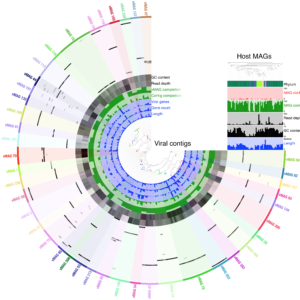ProxiMeta Metagenome Deconvolution Platform »
Includes an 8-pack proximity ligation library prep kit, as well as on-line analysis
Viruses are ubiquitous, infecting bacteria, archaea, and eukaryotes. In microbial systems they shape the evolution and population dynamics of their hosts, both through infection and as vectors of horizontal gene transfer— thus crucially impacting the natural and human-made ecosystems in which they occur.1,2
Metagenomic technologies have become key enablers in the study of environmental viromes. However, shotgun sequencing data lacks the long-range information needed to reconstruct these fragmented genomes. As a result, metagenome assembly and binning pipelines have to rely on a priori knowledge from reference databases and statistical assumptions. These methods can also not tell with certainty which sequences originated from which cell in a complex microbial community. This leaves metagenome-assembled genomes (MAGs) incomplete and contaminated. In addition, conventional binning approaches largely fail in accurately identifying bona fide hosts for the viruses in metagenomic samples, leaving major gaps in our understanding of microbial ecosystems.

Our ProxiMeta™ Metagenome Deconvolution Platform—now powered with the new ProxiPhage™ algorithm—employs proximity ligation (Hi-C) technology to capture physical interactions between sequences within the same cell. ProxiPhage augments metagenomic analysis with this additional layer of linkage information to enable specific and sensitive host attribution of DNA viruses (phages) and reconstructs more, higher-quality bacterial and viral genomes in the process.
 |
Circular plot of viral metagenome-assembled genomes (vMAGs, outer ring), constructed with the ProxiMeta Platform from short-read shotgun and proximity ligation (Hi-C) sequencing data. All 42 vMAGs depicted here consist of at least 3 contigs of ≥5 kb each, and every contig has a physical host connectivity signal. Contigs associated with each vMAG are shown in the same color. Bars within a contig represent physical links to a given microbial MAG reconstructed from the same sample, indicating a viral-host association. Darker bars represent higher estimated copy counts. Bars aligned across a vMAG designate connections of multiple contigs to the same host. Additional circular layers (viral) and bar plots (hosts, upper right) represent characteristics of individual contigs or MAGs, respectively. These include length, GC content and estimated completeness based on alignment to a long-read metagenomic assembly.3 |
Download our bioRxiv preprint, Application Note and World Microbe Forum 2021 Poster to learn more about accurate viral genome reconstruction and host attribution from metagenomic samples.
ProxiMeta Metagenome Deconvolution Platform »
Includes an 8-pack proximity ligation library prep kit, as well as on-line analysis
View example reports or log in
Ultra-long-range Genome Sequencing »
Learn more about our technology